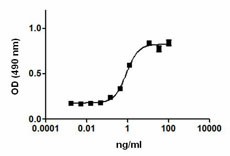- Regulatory Status
- RUO
- Other Names
- Interleukin-2, T cell growth factor (TCGF), Eosinophil differentiation factor (EDF), Killer cell helper factor (KHF), Macrophage-activating factor for cytotoxicity I (MAF-C I), Thymocyte differentiation factor (TDF)

-

HT-2 cell proliferation induced by mouse IL-2. -

Recombinant mouse IL-2 induces the proliferation of mouse HT-2 cell line in a dose dependent manner. BioLegend’s protein was compared side-by-side to a competitor’s equivalent product.
| Cat # | Size | Price | Quantity Check Availability | ||
|---|---|---|---|---|---|
| 575402 | 10 µg | $94.00 | |||
| 575404 | 25 µg | $211.00 | |||
| 575406 | 100 µg | $469.00 | |||
| 575408 | 500 µg | $1465.00 | |||
IL-2 is a potent lymphoid cell growth factor which exerts its biological activity primarily on T cells. Additionally, IL-2 has been found to stimulate growth and differentiation of B cells, NK cells, LAK cells, monocytes, and oligodendocytes.
Product Details
- Source
- Mouse IL-2, amino acids Ala21-Gln169 (Accession # NM_008366) was expressed in E. coli.
- Molecular Mass
- The 150 amino acid N-terminal methionylated recombinant protein has a predicted molecular mass of 17,231 Da. The DTT-reduced protein and non-reduced protein migrates at approximately 18kDa by SDS-PAGE.
- Purity
- Purity is >98%, as determined by Coomassie stained SDS-PAGE.
- Formulation
- 0.22 µm filtered protein solution is in 5 mM NaH2PO4, 5 mM citric acid, 350 mM NaCl, 1 mM TCEP, pH 4.0.
- Endotoxin Level
- Endotoxin level is <0.1 EU/µg (<0.01ng/µg) protein as determined by the LAL method.
- Concentration
- 10 and 25 µg sizes are bottled at 200 µg/mL. 100 µg size and larger sizes are lot-specific and bottled at the concentration indicated on the vial. To obtain lot-specific concentration and expiration, please enter the lot number in our Certificate of Analysis online tool.
- Storage & Handling
- Unopened vial can be stored between 2°C and 8°C for up to 2 weeks, at -20°C for up to six months, or at -70°C or colder until the expiration date. For maximum results, quick spin vial prior to opening. The protein can be aliquoted and stored at -20°C or colder. Stock solutions can also be prepared at 50 - 100 µg/mL in appropriate sterile buffer, carrier protein such as 0.2 - 1% BSA or HSA can be added when preparing the stock solution. Aliquots can be stored between 2°C and 8°C for up to one week and stored at -20°C or colder for up to 3 months. Avoid repeated freeze/thaw cycles.
- Activity
-
ED50 = 0.2 - 1.0 ng/ml, corresponding to a specific activity of 1.0 - 5.0 x106 units/mg, as determined by the dose dependent stimulation of CTLL2 cell proliferation.
The specific activity of recombinant mouse IL-2 is approximately 9.07 x 104 IU/µg when compared against the Non WHO Reference Material for Murine Interleukin-2 (NIBSC code: 93/566) as determined by the dose dependent stimulation of CTLL2 cell proliferation.
ED50 = 0.4 - 2.0 ng/ml, corresponding to a specific activity of 0.5 - 2.5 x106 units/mg, as determined by the dose dependent stimulation of HT-2 cell proliferation.
For more information on specific activity, please visit the Recombinant Protein Unit Conversions page. - Application
-
Bioassay
- Application Notes
-
BioLegend carrier-free recombinant proteins provided in liquid format are shipped on blue-ice. Our comparison testing data indicates that when handled and stored as recommended, the liquid format has equal or better stability and shelf-life compared to commercially available lyophilized proteins after reconstitution. Our liquid proteins are verified in-house to maintain activity after shipping on blue ice and are backed by our 100% satisfaction guarantee. If you have any concerns, contact us at tech@biolegend.com.
- Additional Product Notes
-
Get a 50% discount on this product when purchased in our Activation Bundles. Restrictions apply. Learn more…
-
Application References
(PubMed link indicates BioLegend citation) - Product Citations
-
Antigen Details
- Structure
- Cytokine
- Bioactivity
- Proliferation of T lymphocytes, B cells, anti-inflammatory, hematopoiesis, tumor surveillance
- Cell Sources
- T cells
- Cell Targets
- T cells, B cells, NK cells, LAK cells, monocytes, macrophages, oligodendrocytes
- Receptors
- High affinity heterotrimer of IL-2Rα/β/γ, intermediate affinity homodimer IL-2Rα (CD25; p55; Tac) and heterodimer IL-2Rβ (CD122)/γ; γ-subunit (CD132) in common with IL-4R, IL-7R, IL-13R, IL-15R
- Cell Type
- Embryonic Stem Cells, Hematopoietic stem and progenitors
- Biology Area
- Cell Biology, Stem Cells
- Molecular Family
- Cytokines/Chemokines
- Regulation
- Upregulated by NFAT; downregulated by TCF-8, CIF (colostrum inhibitory factor)
- Gene ID
- 16183 View all products for this Gene ID
- UniProt
- View information about IL-2 on UniProt.org
